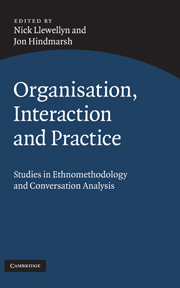Book contents
- Frontmatter
- Contents
- List of contributors
- Preface
- Part I Orientations
- Part II Studies
- 3 A kind of governance: rules, time and psychology in organisations
- 4 On the reflexivity between setting and practice: the ‘recruitment interview’
- 5 The situated production of stories
- 6 Orders of bidding: organising participation in auctions of fine art and antiques
- 7 Some major organisational consequences of some ‘minor’, organised conduct: evidence from a video analysis of pre-verbal service encounters in a showroom retail store
- 8 The work of the work order: document practice in face-to-face service encounters
- 9 The interactional accomplishment of a strategic plan
- 10 Peripherality, participation and communities of practice: examining the patient in dental training
- List of references
- Index
6 - Orders of bidding: organising participation in auctions of fine art and antiques
Published online by Cambridge University Press: 20 May 2010
- Frontmatter
- Contents
- List of contributors
- Preface
- Part I Orientations
- Part II Studies
- 3 A kind of governance: rules, time and psychology in organisations
- 4 On the reflexivity between setting and practice: the ‘recruitment interview’
- 5 The situated production of stories
- 6 Orders of bidding: organising participation in auctions of fine art and antiques
- 7 Some major organisational consequences of some ‘minor’, organised conduct: evidence from a video analysis of pre-verbal service encounters in a showroom retail store
- 8 The work of the work order: document practice in face-to-face service encounters
- 9 The interactional accomplishment of a strategic plan
- 10 Peripherality, participation and communities of practice: examining the patient in dental training
- List of references
- Index
Summary
Introduction
Auctions provide an institutional solution to the pricing and exchange of goods and services of uncertain value. In turn, auctions raise a number of social and organisational issues and problems that have to be resolved by participants themselves in and through interaction (Maynard 1988). For example, an auction of fine art and antiques consists of a gathering of a large number of people, in some cases several hundred, all of whom may have an interest in purchasing the goods on sale if the price is right. The lots in which participants are interested and the price they are prepared to pay is largely unknown, both to fellow buyers and to sale room personnel. The auctioneer has to deploy an organisation that enables the potential contributions of multiple participants to be identified, elicited and co-ordinated so that the price of the goods can be maximised in a transparent manner and sold to the highest bidder. The success of the auction, the valuation and exchange of goods, is dependent upon the participants' belief and trust in the process – that no personal interest or connivance, on behalf of or by the auctioneer, vendor or buyer, has falsely influenced the price and the eventual ownership of the goods. In other words, the neutrality of the auctioneer and the auction house and the integrity of bids – that they are real bids representing actual demand – are critical to the process being, and being seen to be, fair (C. W. Smith 1990).
- Type
- Chapter
- Information
- Organisation, Interaction and PracticeStudies of Ethnomethodology and Conversation Analysis, pp. 119 - 139Publisher: Cambridge University PressPrint publication year: 2010
- 2
- Cited by



